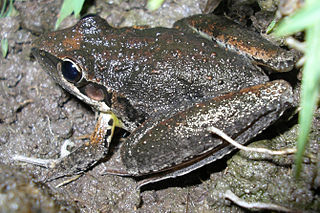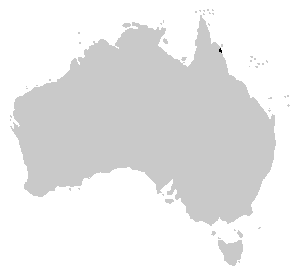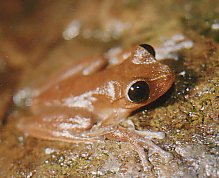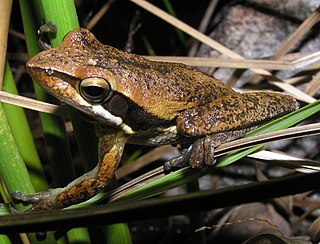
Litoria is a genus of hylid tree frogs, sometimes collectively referred to as Australasian treefrogs, that are native to Australia, the Bismarck Archipelago, the Solomon Islands, New Guinea, the Lesser Sunda Islands, and the Moluccan Islands. They are distinguishable from other tree frogs by the presence of horizontal irises, no pigmentation of the eyelids, and their distribution east and south from Wallacea. Over one hundred species are recognised and new species are still being added, such as the Pinocchio frog discovered in 2008 and described in 2019.

Peron's tree frog, also known as the emerald-spotted tree frog, emerald-speckled tree frog, laughing tree frog, and maniacal cackle frog, is species of tree frog in the subfamily Pelodryadinae. It is a common frog found in Australia.

The white-lipped tree frog is found in Australia and is the world's largest tree frog. Other common names include the New Guinea treefrog, giant tree frog, and Australian giant treefrog.

Tyler's tree frog or the southern laughing tree frog is an arboreal species of tree frog. It is native to eastern Australia where it occurs from south-eastern Queensland to the southern coast of New South Wales. It is generally a coastal species and is not found inland.

The bleating tree frog, also known as Keferstein's tree frog, is a species of tree frog in the subfamily Pelodryadinae. This frog is native to coastal eastern Australia, from south-eastern Queensland, to around Eden, New South Wales.

The broad-palmed frog is a species of ground-dwelling tree frog. It is native to much of eastern Australia. They can be found from mid-Queensland to south of Sydney. It is associated with the coast and inland, and is distributed as far west in New South Wales to the South Australia border.

The Tasmanian froglet is a species of ground-dwelling frog that occurs only in Tasmania, Australia.

The Blue Mountains tree frog also called the Variegated River Tree Frog is a species of tree frog in the family Pelodryadinae. It is endemic to southeastern Australia and is found in eastern Victoria and in southeastern New South Wales. The Jenolan Caves tree frog, a population formerly separated as Litoria jenolanensis, is nowadays included in this species.

The southern brown tree frog, also known as the brown tree frog, whistling tree frog, or Ewing's tree frog, is a species of tree frog native to Australia: most of southern Victoria, eastern South Australia, southern New South Wales from about Ulladulla—although this species is reported to occur further north—and throughout Tasmania including the Bass Strait Islands, in which state it is the most frequently encountered frog. It has been introduced to New Zealand, where it can be locally abundant.

The dainty green tree frog, also known as the graceful tree frog, is a tree frog native to eastern Queensland, and north-eastern New South Wales, Australia. It ranges from northern Cape York in Queensland to Gosford in New South Wales, with a small and most likely introduced population in Hornsby Heights in Sydney. It is the faunal emblem of the City of Brisbane.

The armoured frog, or armoured mist frog, is a species of tree frog in the torrent frog complex, a group restricted to north-eastern Queensland, Australia.

The northern sandhill frog is a small, fossorial frog native to a small region of the Western Australian coast. It was formerly considered the sole species within the genus Arenophryne until the first decade of the 2000s, when a new species of frog called the southern sandhill frog was discovered about 100 kilometres from Geraldton, Western Australia in Kalbarri National Park and given the scientific name Arenophryne xiphorhyncha.

The striped burrowing frog is a species of burrowing frog in the subfamily Pelodryadinae of the family Hylidae. It occurs throughout much of Australia, from northern New South Wales, through eastern and northern Queensland and into eastern Northern Territory. This species was once included in the genus Litoria or Cyclorana.

The Australian lace-lid is a tree frog endemic to the wet tropics of north-eastern Queensland, Australia.

The green-thighed frog is a medium-sized species of ground-dwelling tree frog in Australia.

The desert tree frog, or little red tree frog, is a species of tree frog native to Australia, southern New Guinea, and Timor. It is one of Australia's most widely distributed frogs, inhabiting northern Australia, including desert regions and much of temperate eastern Australia. It is one of the few Australian tree frogs to inhabit arid, tropical, and temperate climates.

The slender tree frog is a tree frog native to south-western Australia.

The orange-thighed frog is a species of tree frog native to a small area of tropical northern Queensland, Australia. It is a green frog with distinctly orange eyes, and is very similar in appearance to the red-eyed tree frog.

Ranoidea verrucosa, the rough frog, is an amphibian native to northern New South Wales and south-eastern Queensland, Australia. It has also been classified under the genera Cyclorana and Litoria and is also known as the woodland water-holding frog, warty water-holding frog, and red-backed cyclorana.
Nyctimystes tyleri is a species of frog in the subfamily Pelodryadinae of the family Hylidae. It is endemic to Papua New Guinea and only known from its type locality, Gapaia Creek, between Garaina and Saureli, in the Morobe Province. The specific name honours Michael J. Tyler, an Australian herpetologist, "in recognition of his notable contributions to the systematics of Australo-papuan frogs." Common name Tyler's big-eyed treefrog has been coined for this species.





















